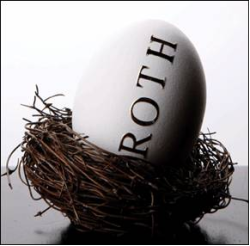For IRA distribution purposes, all IRAs (except Roth IRAs) are considered one big giant IRA. It doesn’t matter if you have one IRA that was rolled over from a former employer, and one SEP IRA with your current employer, and one contributory IRA where you put annual contributions, and one after-tax IRA where you put contributions for which you do not take a deduction. All four IRAs will be considered one IRA any time you take a distribution.

Since they are all one IRA for distribution purposes, you cannot separate out any one component of your IRAs. You cannot take out or convert only the after-tax funds in your IRA. All distributions or conversions will be treated pro-rata.
You track your after-tax IRA funds on IRS Form 8606. The form must be filed with your tax return in any year that you make an after-tax contribution (or rollover after-tax funds from an employer plan to your IRA), and it must be filed in any following year when you take a distribution from your IRA. The form will calculate the amount of your distribution that is taxable.
Put simply, the form takes the total year-end balance of all your IRAs and divides that into the total balance of all after-tax amounts in all IRAs. The resulting percentage is then applied to the distribution to determine the tax-free portion of the distribution. The remaining balance of the distribution is taxable. The tax-free amount of the distribution will reduce the total after-tax amount carried forward to your next Form 8606.
Example: John has a rollover IRA from a previous employer of $270,000 and an “after-tax” IRA account with $30,000 of total contributions in it. John takes a distribution of $30,000 from his after-tax account and converts it to a Roth IRA. His total account balance is $300,000 ($270,000 + $30,000 = $300,000). 10% of his distribution will be tax free ($30,000 / $300,000 = 10%). He will pay income tax on $27,000 ($30,000 X 10% = $3,000 tax free, balance $30,000 - $3,000 = $27,000 taxable). Even though he has closed his after-tax IRA, his rollover IRA balance will now include the remaining after-tax balance of $27,000 ($30,000 after-tax balance - $3,000 distributed = $27,000).
As you can see from the calculation, it won’t matter what IRA account you take the distribution from. Some of the distribution will be taxable and some will be tax-free. The overall totals of your pre-tax and after-tax amounts will be reduced without regard to the account the funds came from.
This is another installment in our weekly look at The Slott Report's "Best of 2013". New articles return next week!
-By Beverly DeVeny and Jared Trexler

Since they are all one IRA for distribution purposes, you cannot separate out any one component of your IRAs. You cannot take out or convert only the after-tax funds in your IRA. All distributions or conversions will be treated pro-rata.
You track your after-tax IRA funds on IRS Form 8606. The form must be filed with your tax return in any year that you make an after-tax contribution (or rollover after-tax funds from an employer plan to your IRA), and it must be filed in any following year when you take a distribution from your IRA. The form will calculate the amount of your distribution that is taxable.
Put simply, the form takes the total year-end balance of all your IRAs and divides that into the total balance of all after-tax amounts in all IRAs. The resulting percentage is then applied to the distribution to determine the tax-free portion of the distribution. The remaining balance of the distribution is taxable. The tax-free amount of the distribution will reduce the total after-tax amount carried forward to your next Form 8606.
Example: John has a rollover IRA from a previous employer of $270,000 and an “after-tax” IRA account with $30,000 of total contributions in it. John takes a distribution of $30,000 from his after-tax account and converts it to a Roth IRA. His total account balance is $300,000 ($270,000 + $30,000 = $300,000). 10% of his distribution will be tax free ($30,000 / $300,000 = 10%). He will pay income tax on $27,000 ($30,000 X 10% = $3,000 tax free, balance $30,000 - $3,000 = $27,000 taxable). Even though he has closed his after-tax IRA, his rollover IRA balance will now include the remaining after-tax balance of $27,000 ($30,000 after-tax balance - $3,000 distributed = $27,000).
As you can see from the calculation, it won’t matter what IRA account you take the distribution from. Some of the distribution will be taxable and some will be tax-free. The overall totals of your pre-tax and after-tax amounts will be reduced without regard to the account the funds came from.
This is another installment in our weekly look at The Slott Report's "Best of 2013". New articles return next week!
-By Beverly DeVeny and Jared Trexler























